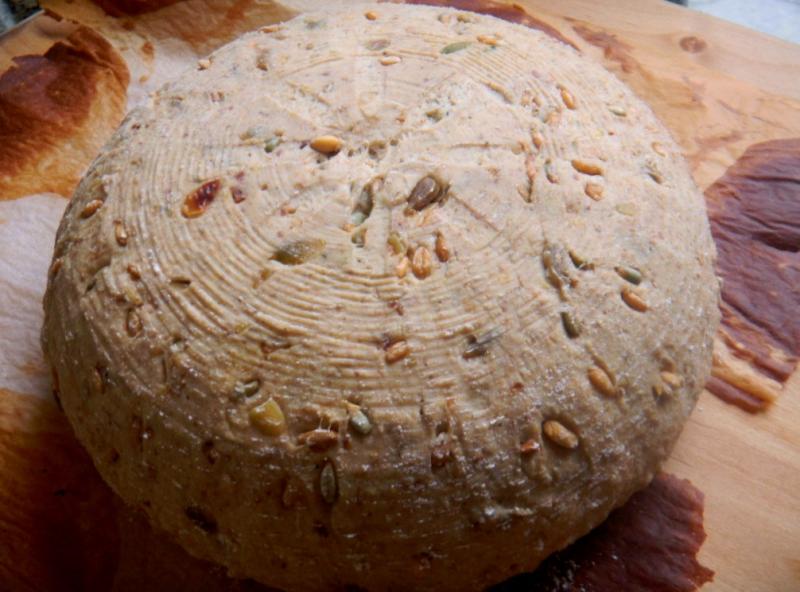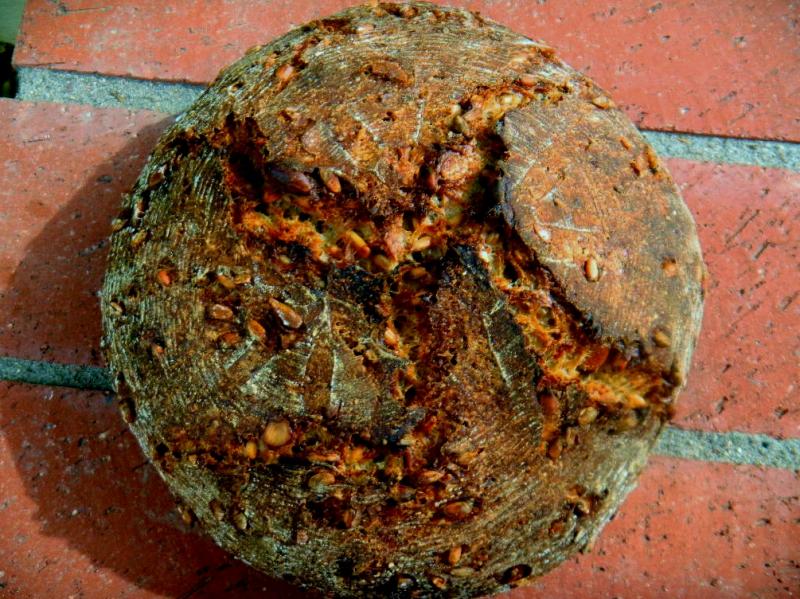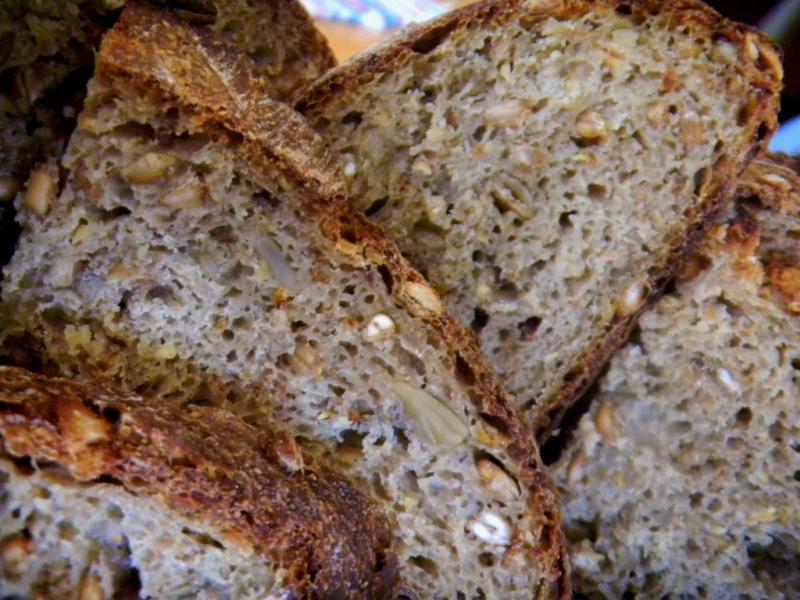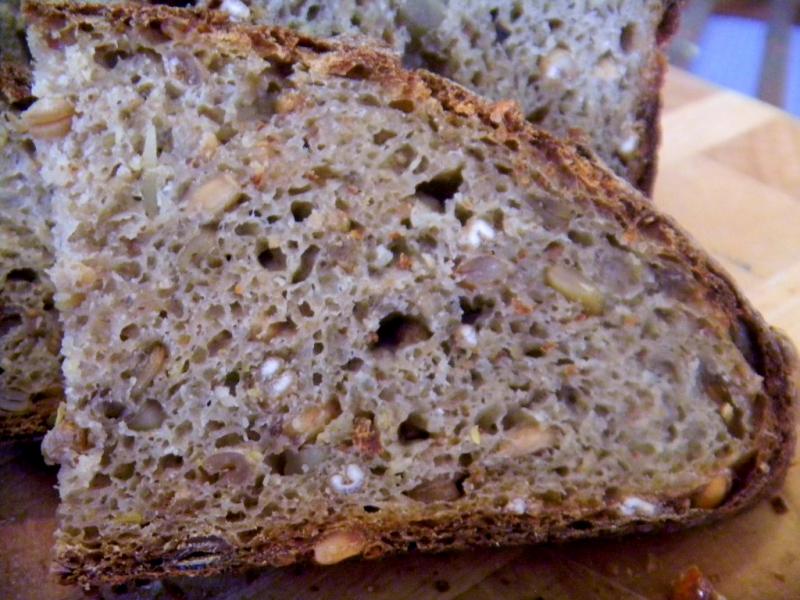Lucy figured it was time to get back to baking the kind of bread that she likes but I reminded her we still have a couple of half loaves of SD pumpernickel in the freezer along with some white breads and who knows what else.

So we compromised by baking one of my favorite kind of breads - even though I like them all. This one is a 60% mix of 8 whole grains, sourdough, has oat and potato in it along with home made red and white malts and sprouts, honey, pumpkin, sunflower, flax and sesame seeds. The liquid is a mix of excess sprout soaker water but mainly yogurt whey.


Even though rye chits in 24 hours, the rest of the grains take 48 hours to chit when making sprouts so you need to start the sprouting at the same time as the SD levain if you want to have it ready when you mix the dough 48 hours later if you want to refrigerate the levain for 24 hours after the 3rd stage feeding.

We always have yogurt whey on hand since we regularly make our own but if you buy a quart of the cheapest plain yogurt at the store and drain it in the fridge for 4 hours, through a colander with a sheet of paper towel in the bottom, you will make really expensive Greek yogurt and have whey for your bread too. A twofer if there ever was one.

Per our new normal using a heating pad in the winter, we made the SD levain over 3 stages from our whole multigrain 66% starter that had been undisturbed for 4 weeks in the fridge getting sourer by the day in the cold. The first stage was 3 hours where it rose 25% and the 2nd stage was right at 4 hours before it doubled.

We then fed it the 3rd time and after it rose 25% after about an hour we then refrigerated it for 24 hours. The next day it was placed back on the heating pad and allowed to double, which took about 3 hour,s while we autolysed the rest of the dry, less the seeds and salt. We held back little bit of whey to dissolve the salt to add in later.

After out last bake that was too wet and the dough spread, we decided that this bread would be better at 81% hydration including the add ins. After everything was mixed we let it sit for half and hour. The dough certainly felt and performed better that the last bake and was still wet enough to do the 3 sets of slap and folds of 8, 1.and 1minutes without difficulty.

3 sets of stretch and folds were done on 20 minute intervals where the ground sesame and flax, pumpkin and sunflower and sprouts were incorporated on the first 3 and evenly distributed by the 4th one. Once everything was in the dough, we shaped it in to a ball and put it in the fridge for a 12 hour retard in bulk like Ian or Peter Reinhart would do.

By the next morning it had doubled in the fridge and we put the dough on the heating pad to warm up for 1 ½ hours before shaping it into a boule and putting it seam side down in a rice floured basket to final proof so that we could bake it upside down with out slashing and letting the bread crack at the seams as it sprang in the oven.

Yes ,it's a BLT - very special since we only have a couple a year.
After 1 3/4 hours we fired up Big Old Betsy and let it hit 500 F and stay there for 20 minutes to let the top and bottom stones catch up. This time we decided to bake this bread on the bottom stone while covering it with or Goodwill $1 aluminum Dutch oven bottom as a cloche.

As soon as the bread was overturned onto parchment on a peel and slid into the oven and covered with hot preheated cloche, the temperature was turned down to 475 F for the 18 minutes the bread was steamed with its own steam.

Once the lid came off, the oven was turned down to 425 F convection this time and the inside hit 203 F right at 12 minutes later when the oven was turned off. Total baking time was 30 minutes for this smallish loaf.

Once the bread hit 205 F we opened the door of the oven, leaving it ajar and let bread sit on the hot stone till the bread hit 207 F on the inside when it was removed to the cooling rack. It sprang and browned very well and cracked handsomely. The crust was very crunchy when it came out of the oven too. The crumb was fairly open for a bread so high in whole grains, sprouts and seeds. It was a medium well for sour because of the whey and there are lots of bits in the crumb. The crust stayed a little crisp and was boldly baked just the way we like it. Between the fine flavor of the crust and crumb that is nutty, tangy and deep, there isn't much not to like about this fine bread. It would be a fine candidate for Lucy's DaPumperizing method.

Formula |
| Build 1 | Build 2 | Build 3 | Total | % |
Multigrain SD Starter | 20 | 0 | 0 | 20 | 5.73% |
Whole Multigrain Mix | 16 | 24 | 40 | 80 | 22.92% |
Water | 16 | 24 | 40 | 80 | 22.92% |
Total | 52 | 48 | 80 | 180 | 51.58% |
| | | | | |
Multigrain SD Levain | | % | | | |
Whole Multigrain Mix | 90 | 25.79% | | | |
Sprout Soaker Water | 90 | 25.79% | | | |
Hydration | 100.00% | | | | |
| | | | | |
Levain % of Total | 21.40% | | | | |
| | | | | |
Dough Flour | | % | | | |
AP | 130 | 37.25% | | | |
Potato Flakes | 12 | 3.44% | | | |
Whole Multigrain Mix | 117 | 33.52% | | | |
Dough Flour | 259 | 74.21% | | | |
| | | | | |
Salt | 7 | 2.01% | | | |
Yogurt Whey | 200 | 57.31% | | | |
Dough Hydration | 77.22% | | | | |
| | | | | |
Dough Hydration w/ starter | 83.09% | | | | |
| | | | | |
Total Flour | 349 | 100.00% | | | |
Soaker Water 82 & Whey | 290 | 83.09% | | | |
| | | | | |
Hydration w/ Adds | 81.31% | | | | |
% Whole Grain | 60.00% | | | | |
| | | | | |
Total Weight | 841 | | | | |
| | | | | |
Add - Ins | | % | | | |
Honey | 12 | 3.44% | | | |
White Malt | 3 | 0.86% | | | |
Red Malt | 3 | 0.86% | | | |
Pumpkin & Sunflower Seeds | 40 | 11.46% | | | |
G. Flax, G Sesame Seed | 25 | 7.16% | | | |
VW Gluten | 12 | 3.44% | | | |
Total | 95 | 27.22% | | | |
| | | | | |
Sprouts | | % | | | |
Whole Multigrain Berries | 100 | 28.65% | | | |
| | | | | |
Whole Mulitgrain Mix is: barley, emmer, Kamut, | | | |
spelt, rye, oat, buckwheat and wheat | | | | |
| | | | | |
60% whole grain does not include the whole | | | |
grain soaker. It is 70% with the soalker. | | | |
